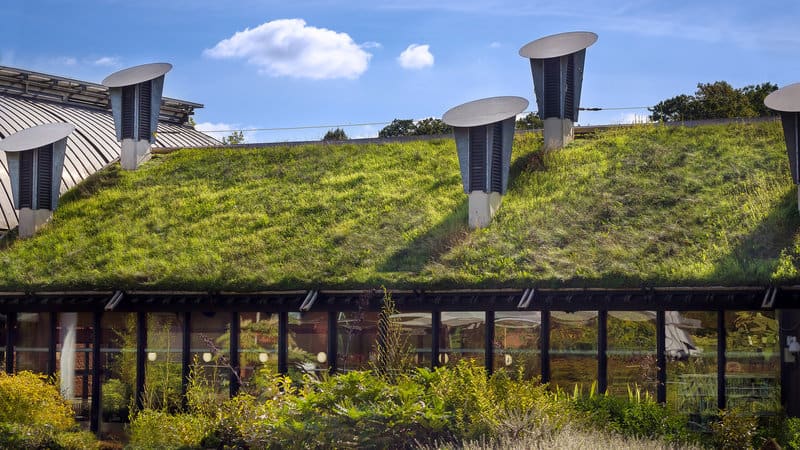
In recent years, there has been a growing trend toward “green” alternatives. People are finding out that they can enjoy all the same luxuries in life while being kinder to the environment. In fact, eco-responsible options have become a fashion trend.
As this green trend grows, more and more Americans are interested in a green roof. Also called a living roof, this type of roof is covered in plants that add to your ecosystem. Roof gardens, which are popular in major cities and high-end buildings, are a type of green roof.
Still, there are a lot of misconceptions and myths about green roofs. Our experts are here to answer your questions and set the record straight.
Myths About Green Roofs
Despite how popular they are around the world, green roofs are still a rarity in the United States. Part of the problem may be the myths and rumors that float around. Check out the most common myths we hear and the facts behind them:
Myth 1: Green Roofs Don’t Hold Temperature Well
Perhaps the reason for this misconception is that people don’t realize how much weatherproofing and structure a green roof actually has. It’s a far cry from a tarp with some soil and grass on it.
In reality, green roofs can help your home be more energy-efficient, especially in the summer. The plants soak up the sun’s rays and use it for their own energy before it can overheat your house.
A study in Canada found that green roofs can reduce daily energy usage by 75% in the summer. Imagine taking 75% off your energy bill during the hottest months of the year.
Myth 2: Green Roofs are a Recent Development
Plenty of homeowners are afraid of green roofs because they think they’re new and haven’t been studied well. In truth, green roofs extend all the way back to ancient times.
Green roofs started taking a more modern form in the 20th century. Rockefeller Center in New York City has had a roof garden since 1936. In Germany, green roofs started getting more popular in the 1980s and 1990s. In fact, today about 10% of roofs in Germany are green roofs.
Myth 3: Green Roofs are Difficult to Irrigate
The cost to irrigate your green roof will vary. It depends on your local climate as well as the types of plants you choose. It can also shift based on the time of year and how much rain you’re getting.
Every modern green roof should have a built-in irrigation system. You can include a system that reuses excess rainwater to reduce your water usage.
Keep in mind that some green roofs are created like a garden you can walk into. In this case, watering your roof garden is no more difficult than watering your lawn or your landscaping.
Myth 4: Green Roofs Cause Leakage
Going back to our point about energy efficiency, green roofs are most secure than many people realize. They have waterproofing and barriers beneath the plants that protect your home from the weather. They should also have a root barrier so plant roots don’t grow too deep and damage your home’s structure.
Green roofs are no more susceptible to leaks and problems than traditional roofs. In fact, some studies suggest that they’re more durable.
The plants soak up the sun’s rays so it does less damage to the weatherproofing underneath. This can enable the green roof weatherproofing to last longer than that of a traditional roof. The roof garden on Rockefeller Center is said to still have it’s original weatherproofing from 1936.
Myth 5: A Green Roof is a Great DIY Project
Some homeowners think, “I planted my own landscaping, so I can do the same thing on my roof, right?”
This is an incorrect assumption. Before you even start, a professional needs to inspect your home to make sure it’s structurally prepared for a green roof. The components can be weighty, and not all buildings are compatible with a green roof.
In order for a green roof to be durable and successful, you need to build in certain structures your soil naturally has. You need a water barrier, an irrigation system, a root barrier, and more. Most green roofs also don’t use soil but use other types of porous material.
When it comes down to it, you could make too many expensive mistakes if you try to install a green roof yourself. It’s best in the long run to hire a professional.
Myth 6: Green Roofs are Too Expensive
Some homeowners hear about all the different components of a green roof and assume it’s out of their price range. In reality, it isn’t as expensive as many people think.
According to the Environmental Protection Agency, green roofs can range from $10 to $25 per square foot to install. While this may sound high compared to a shingle roof, keep in mind that green roofs can last much longer. It’s also important to remember that the low end of this estimate is similar to what you’d pay to install a metal roof.
There are a few other considerations to keep in mind as well. If you live in a hot environment, don’t forget to account for your energy savings. You also have the option of only “greening” part of your roof. Many high-end city buildings choose this path.
Is a Green Roof Right for Your Home?
Most homeowners and property managers don’t consider a green roof. They either don’t realize it exists or they have incorrect assumptions about it. The myths about green roofs above have deterred many homeowners who could enjoy great benefits and prefer the unique style a green roof provides.
Now that you know the facts, it’s time to find out if a green roof is a good option for your home. Contact our experienced roofing professionals to find out if you can enjoy a green roof and find out your expected cost.

